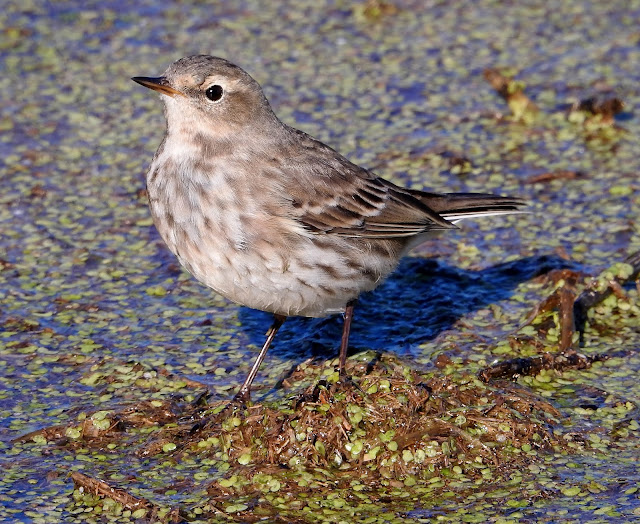%2020.jpg)
The Water Pipit (Anthus spinoletta) is a small, sprightly passerine bird, a denizen of the mountains of Southern Europe and the Palearctic, extending its range eastwards to the vastness of China. This bird is a short-distance migrant, often descending to lower altitudes or seeking the openness of wet lowlands when winter's grip takes hold.
In its breeding attire, the Water Pipit dons greyish-brown upperparts, modestly streaked with a darker hue, and a pale pink-buff on the underparts, which gently fades to a whitish tone on the lower belly. The head is adorned with a grey crown and a striking broad white supercilium, while the outer tail feathers flash white. Come winter, the plumage is more subdued; the head becomes grey-brown, the supercilium less pronounced, and the upperparts bear more pronounced streaking. The underparts transition to white, with light brown streaks gracing the breast and flanks. The three subspecies show only minor variations, and both sexes present a near-identical appearance, with the young resembling the adults.
The Water Pipit is a bird of the high mountains during the breeding season, favoring alpine meadows and pastures with short grass, often near wet areas or slopes.
This species breeds in the mountainous regions of southern Europe and across Asia to central China, with some populations residing on the Mediterranean islands of Sardinia and Corsica. In winter, many birds migrate to coastal wetlands, marshes, and rice fields.
%2021.jpg)
The Water Pipit is a bird that values its privacy, often proving more elusive and wary than its relatives. When disturbed, it takes to the wing, flying a considerable distance before alighting once more.
The Water Pipit's song is a series of four or five blocks, each composed of about six repetitions of a distinct short note, performed from a perch or during flight. Its call is a sharp "dzip," and its flight call a short, thin "fist," sitting between the calls of the Meadow and Rock Pipits.
Nests are artfully constructed cups of grass and leaves, concealed under vegetation or within cliff crevices. Clutches typically consist of four to six speckled greyish-white eggs, which incubate for about two weeks, with fledging occurring after another 14-15 days.
The Water Pipit's diet is primarily composed of small invertebrates, which it picks off the ground or vegetation. It occasionally catches insects mid-flight and may also consume some plant material, particularly in areas where insects are less abundant.
The Water Pipit is classified as Least Concern by the IUCN, with a large and stable population spread across a vast range. Estimates suggest a European breeding population that could reach up to two million pairs, indicating a global population of tens of millions.






















%60%2020.jpg)
%60%2021.jpg)
%60%2022.jpg)
%2020.jpg)
%2021.jpg)
%2022.jpg)








%2020.jpg)
%2021.jpg)



%20%2020.jpg)
%20%2021.jpg)
%20%2022.jpg)
%2020.jpg)